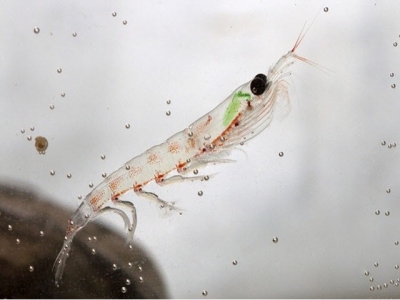Krill meal ranked top in study assessing growth enhancers in shrimp

Trial findings support the use of krill meal as an effective growth enhancer in fishmeal-challenged diets for whiteleg shrimp, says krill meal producer, Aker BioMarine.
The company collaborated in a study, which was published in the Journal of the World Aquaculture Society, and led by Dr Alberto Nunes from the Instituto de Ciências do Mar, Brazil (Labomar). The trial assessed the feed preference and the growth response of juvenile whiteleg shrimp (Litopenaeus vannamei) to different marine chemoattractants.
Dr Lena Burri, director R&D, animal nutrition and health, Aker BioMarine, told FeedNavigator about the prompt for the trial:
“Intensive shrimp farming has extensively used fishmeal for its nutrient composition and high attractability, but stagnant supplies and increasing prices have led to the use of alternative protein sources such as plant and rendered animal byproducts.
“While these changes have the advantages of reducing cost and increasing sustainability of aquaculture, they can also severely impact shrimp growth. Reasons may include the absence of essential nutrients, lower attractability and palatability and antinutritional factors that can suppress feeding stimulus and reduce nutrient bioavailability.
“A good feed attractant may help to overcome these issues, but there may be differences in effectiveness, when different sources such as fish, krill, mollusks, shrimp, or squid are compared. This study tried to determine which marine feed attractant gives the best growth performance of shrimp.”
Methodology
In the trial with Labomar, AkerBioMarine said that a whiteleg shrimp diet with 3% fishmeal was supplemented with either 3% krill meal, squid meal, shrimp head meal, shrimp meal, squid liver meal, salmon meal, soy protein concentrate (SPC), or 5% liquid sardine hydrolysate.
There were under 100 animals/m2 in 56 1-m3 tanks, and shrimp were fed 10 times daily for 74 days, said the company.
At harvest, the shrimp were counted, weighed, and their growth performance and feed efficiency determined. In order to evaluate feed preference, two-by-two comparisons were carried out, with diets with different chemoattractants delivered simultaneously in two separate feeding trays allocated in each tank, added the company.
Results
The results, it continued, showed that krill meal is the most effective growth enhancer in fishmeal-challenged diets for whiteleg shrimp; the final body weight was highest for shrimp fed with krill-meal supplemented diet (11.97 ± 0.93 g), followed by salmon meal (11.11 ± 0.77 g), and squid meal (11.01 ± 1.17 g).
When asked how krill meal promotes a stimulatory effect on shrimp feed intake and feed preference, Dr Burri explained:
“Water-soluble, low molecular weight compounds, free amino acids, nucleotides, nucleosides, quaternary ammonium compounds, phospholipids, biogenic amines and monosaccharides have all been identified as feeding effectors that improve attractability and palatability of diets. Krill meal is a combination of several of these low molecular weight compounds that work together as efficient feeding effectors.”
Were the shrimp challenged during the trial, and, if not, would the krill meal likely have the same effect in a challenge situation?
“No, the shrimp were not challenged, but we have used krill meal in challenging conditions, such as high salinity, previously and have found growth benefits,” she said.
Improved performance seen in grape extract fed shrimp
In January 2018, we heard from French plant extracts company, Nor Feed, about a trial it had done in conjunction with a university in Taiwan showing that its grape extract product, Nor-Grape 80, could replace vitamin E in the starter period of whiteleg shrimp production.
The Angers headquartered firm said replacement of that vitamin with the grape extract, an uncommon approach, led to an improvement of the feed conversion ratio (FCR) in all supplemented groups. No difference was observed in terms of mortality between groups, it added.
Paul Engler, R&D manager of the company’s Nor-Grape range, talked to us about the outcome of that study. He said the results came as a kind of surprise to Nor Feed.
“We were not expecting that Nor-Grape 80 fed shrimps would perform better than those fed the control diet with 100 ppm vitamin E. We had been expecting the trial groups to be equivalent to the control group in terms of final weight or FCR, not better.”
The fact that the team saw such a positive outcome in the shrimp given the Nor-Grape supplemented diets would indicate that by diversifying the sources of antioxidants, scientists can play on different metabolic pathways and, therefore, achieve a more balanced antioxidant defense in the animal, leading to improved performance later on, said Engler.
He said the grape extract has also been tested and used in salmon, sea bream, sea bass and grey mullet among other aquaculture species.
“We are working not only on shrimp but on multiple species and trying to better understand the mode of action of Nor-Grape 80, on a more general basis. For us at Nor Feed, it is very important to know how exactly how the extracts work, so as to provide more concrete data for our clients and users.”
Source: Journal of the World Aquaculture Society
Authors: A JP Nunes, H Sabry-Neto, S. Oliveira-Neto, L Burri
Có thể bạn quan tâm
 GOAL 2019 Global shrimp production review
GOAL 2019 Global shrimp production review The change has shifted China’s shrimp production estimates lower by about 100,000 metric tons (MT) in most of those years. Despite this adjustment
 Study of co-infection of WSSV and Vibrio parahaemolyticus
Study of co-infection of WSSV and Vibrio parahaemolyticus Acute hepatopancreatic necrosis disease (AHPND), caused by specific strains of the bacterium Vibrio parahaemolyticus (VpAHPND), has been reported in shrimp
 Dr Loc’s key steps to antibiotic-free shrimp production
Dr Loc’s key steps to antibiotic-free shrimp production Producing shrimp without the use of antibiotics is a realistic goal for all shrimp producers, according to Loc Tran, founder of ShrimpVet.